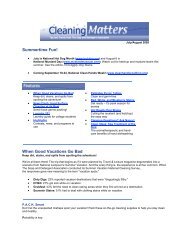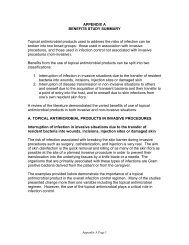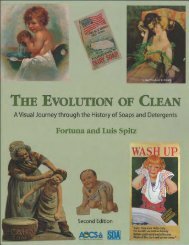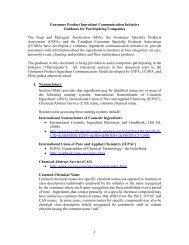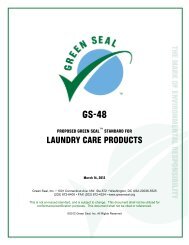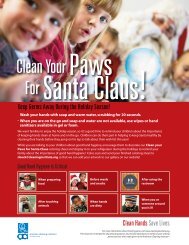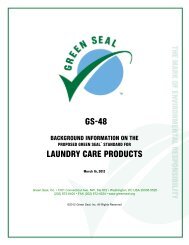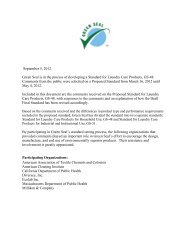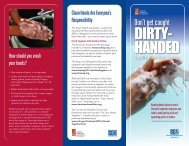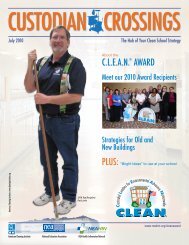subchapter c -- federal hazardous substances act regulations
subchapter c -- federal hazardous substances act regulations
subchapter c -- federal hazardous substances act regulations
Create successful ePaper yourself
Turn your PDF publications into a flip-book with our unique Google optimized e-Paper software.
Such articles manuf<strong>act</strong>ured outside the United<br />
States are introduced into interstate commerce<br />
when first brought within as U.S. port of entry.<br />
Such articles manuf<strong>act</strong>ured in the United<br />
States are introduced into interstate commerce<br />
(a) at the time of first interstate sale, or (b) at<br />
the time of first intrastate sale if one or more<br />
components and/or raw materials were<br />
received interstate, whichever occurs earlier.<br />
(2) Exemptions. (i) Toys and other<br />
children’s articles that are the subject of any of<br />
the following <strong>regulations</strong> are exempt from this<br />
§ 1500.49: The <strong>regulations</strong> for bicycles, nonfull-size<br />
baby cribs, and full-size baby cribs<br />
(parts 1508, 1509, and 1512 of this chapter).<br />
(ii) Toys that by reason of their functional<br />
purpose necessarily present the hazard of sharp<br />
metal or glass edges and that do not have any<br />
nonfunctional sharp metal or glass edges are<br />
exempt from this section: Provided, the toy is<br />
identified by a conspicuous, legible, and<br />
visible label at the time of any sale, as having<br />
functional sharp metal or glass edges.<br />
Examples of these are a pair of toy scissors<br />
and toy tool kits.<br />
(iii) Articles, besides toys, intended for use<br />
by children that by reason of their functional<br />
purpose necessarily present the hazard of sharp<br />
metal or glass edges and that do not have any<br />
non-functional sharp metal or glass edges are<br />
exempt from this section. Examples of these<br />
are children’s ice skates and children’s cutlery.<br />
(3) Definitions — (i) Glass. For the<br />
purpose of this regulation the Commission<br />
defines glass as a hard, brittle, amorphous<br />
substance produced by fusion, usually<br />
consisting of mutually dissolved silica and<br />
silicates that also contain soda and lime.<br />
(ii) Metal. For the purpose of this<br />
regulation the Commission intends the word<br />
metal to include both elemental metals and<br />
metal alloys.<br />
(c) Accessibility — (1) General. Any metal<br />
or glass edge that is accessible either before or<br />
after the test of §§ 1500.51, 1500.52, and<br />
1500.53 (excluding the bite test-paragraph (c)<br />
of each section) are performed shall be subject<br />
to the sharp edge test of paragraph (d) of this<br />
section. Toys reasonably intended to be<br />
assembled by an adult and not intended to be<br />
taken apart by a child shall be tested only in<br />
the assembled state if the shelf package and<br />
the assembly instructions prominently indicate<br />
16 CFR Ch. II (1–1–05 Edition)—proposed modificication – 6/25/06<br />
-- 53 --<br />
that the article is to be assembled only by an<br />
adult.<br />
(2) Accessible edges. (i) An accessible<br />
metal or glass edge for a toy or article intended<br />
for children 3 years of age or less is one that<br />
can be cont<strong>act</strong>ed by any portion forward of the<br />
collar of the accessibility probe designated as<br />
probe A in Figure 2 of this section.<br />
(ii) An accessible edge for a toy or article<br />
intended for children over 3 years and up to 8<br />
years of age is one that can be cont<strong>act</strong>ed by<br />
any portion forward of the collar of the<br />
accessibility probe designated as Probe B in<br />
Figure 2 of this section.<br />
(iii) An accessible edge for a toy or article<br />
intended for children of ages spanning both<br />
age groups is one that can be cont<strong>act</strong>ed by any<br />
portion forward of the collar of either Probe A<br />
or Probe B, as shown in Figure 2 of this<br />
section.<br />
(3) Insertion depth. (i) For any hole,<br />
recess, or opening having a minor dimension<br />
(the minor dimension of an opening is the<br />
diameter of the largest sphere that will pass<br />
through the opening), smaller than the collar<br />
diameter of the appropriate probe, the total<br />
insertion depth for accessibility shall be up to<br />
the collar on the appropriate probe. Each probe<br />
joint may be rotated up to 90 degrees to<br />
simulate knuckle movement.<br />
(ii) For any hole, recess, or opening having<br />
a minor dimension larger than the collar<br />
diameter of Probe A, but less than 7.36 inches<br />
(186.9 millimeters), when Probe A is used, or<br />
a minor dimension larger than the collar<br />
diameter of Probe B, but less than 9.00 inches<br />
(228.6 millimeters), when Probe B is used, the<br />
total insertion depth for accessibility shall be<br />
determined by inserting the appropriate probe<br />
with the extension, shown in Figure 2, in any<br />
direction up to 2 1 ⁄ 4 times the minor dimension<br />
of the hole, recess, or opening, measured from<br />
any point in the plane of the opening. Each<br />
probe joint may be rotated up to 90 degrees to<br />
simulate knuckle movement.<br />
(iii) For any hole, recess, or opening having<br />
a minor dimension of 7.36 inches (186.9<br />
millimeters) or larger when Probe A is used, or<br />
a minor dimension of 9.00 inches (228.6<br />
millimeters) or larger when Probe B is used,<br />
the total insertion depth for accessibility is<br />
unrestricted unless other holes, recesses, or<br />
openings within the original hole, recess, or<br />
opening are encountered with dimensions



